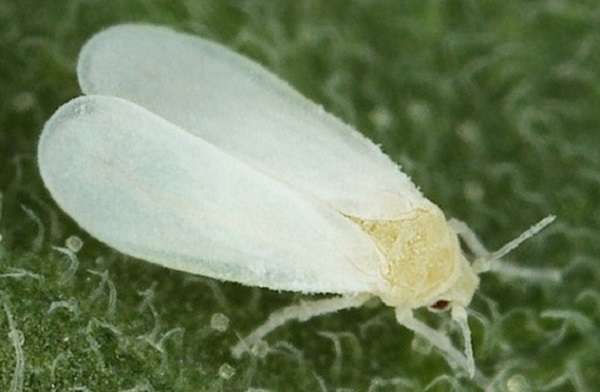 Growing tomatoes in a greenhouse is much more profitable than in open beds. Harvest can be obtained much earlier, and the fruiting period is significantly extended, and if the structure is also heated, then in general you can provide your family with your favorite fruits all year round.
Growing tomatoes in a greenhouse is much more profitable than in open beds. Harvest can be obtained much earlier, and the fruiting period is significantly extended, and if the structure is also heated, then in general you can provide your family with your favorite fruits all year round.
But growing in a greenhouse has its drawbacks. And most importantly - the microclimate, which is loved not only by tomatoes, but also by pests. One of the most dangerous is the whitefly, which is able to destroy the entire crop as soon as possible.
Content
Pest characterization
Whitefly got its "folk" name due to appearance. The butterfly is very similar to a moth, but only it is smaller and has white elongated wings. The scientific name for the pest related to the flying small insect-winged insect is Aleirodida. The body of the butterfly is small, about 2 mm.
In nature, there are more than 300 species of butterflies of this species. They live around the world in a moderately humid and warm climate.
On the territory of our country there are only a few types of voracious pests and all of them are very dangerous for tomatoes. Although the butterflies are affected not only by them, but also by other plants growing nearby on the site.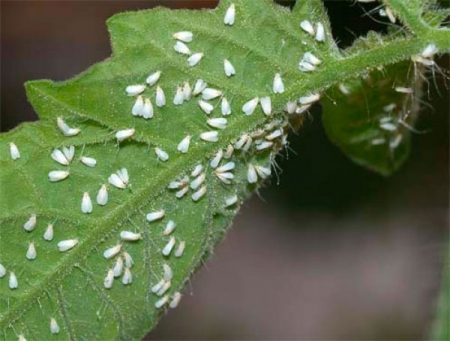
Whitefly Life Cycle
In order for the whitefly to appear in the greenhouse, at least one adult female must get there. A butterfly settles on the underside of the leaf and begins to lay eggs. They have an oblong shape and white color. In total, a week and one “mother” will have more than 200 “children”.
The eggs are hard to spot. If the butterfly is only 2 mm long, then how small her eggs are! But if you wish, you can still notice them. After all, 200 pieces are not five or ten.
In comfortable living conditions, a larva will hatch from the egg in a week. This tiny worm moves in search of the most suitable “place of residence”. Having discovered it, the insect stops moving, stops and begins to actively eat, growing literally "in front of our eyes."
It is at this moment of immobility that all measures taken to destroy the pest will bring maximum results.
Two weeks later, the yellowish and translucent body of the worm will cover a white coating. It is very dense and resembles a wax. Performs primarily a protective function.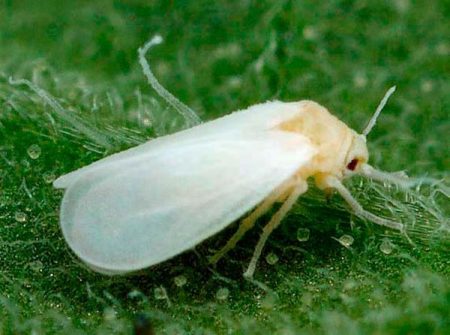
The next phase comes and the worm turns into a chrysalis. At this moment, the insect is not afraid of any methods that a gardener can take to fight them, so that you can not waste your strength. The period lasts approximately 14-16 days, and then the whitefly stops in the imago.
This is almost an adult individual, a few days remain, and it will be able to fly from place to place and give offspring. Although as long as there is free space on the bush and enough juice for food, there is no point in looking for a new insect.
Whitefly develops very quickly, and the warmer and wetter the air, the more actively these processes occur.
A whitefly living in a calf is capable of 15 “approaches” of laying eggs per season.
Signs of occurrence
Detecting the presence of whiteflies is quite difficult. But this is quite possible even at the very first stage of egg laying. It is only necessary to regularly inspect the plantings, paying particular attention to the inside of the tomato leaf.
A greenhouse, a greenhouse, a greenhouse and other rooms with a warm and humid microclimate are an ideal environment for the development of an insect. And juicy leaves and stems of plants - the best delicacy for him.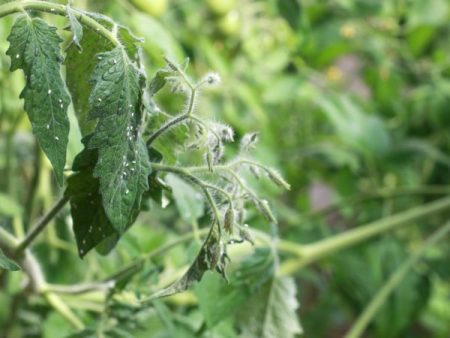
It is possible to determine that plantings are susceptible to attack by a pest only visually. But this is at the very beginning. If we are talking about whole "families", just touch the bush. This will cause the white cloud to take off. A flock of butterflies soars up. It will be impossible not to notice them.
Symptoms of lesion
The following symptoms of butterfly damage to plantings should cause alarm among gardeners:
- the color of the plant becomes cloudy, they become sticky, acquire a “lacquer” coating;
- dots appear on the leaves, similar to mold;
- young leaves begin to curl and fade, in a neglected state, the same signs appear on older leaves;
- a yellowish “mosaic” appears on the sheet plate;
- the fruits rot, dry and die;
- fungal diseases begin.
The more the defeat stage is launched, the more difficult it is to fight whiteflies. Only timely measures can protect the landing from absolute death.
Whitefly Damage
The pest butterfly is very dangerous. She feeds on the juice of plants, absorbing it in large quantities. After each "meal" on the surface there are punctures through which the infection can penetrate. Such wounds also prevent photosynthesis from normal.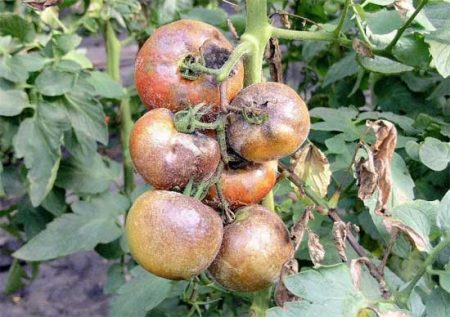
With a small number of insects on tomatoes, their growth slows down. If you do not take action, the plant will begin to dry, wither and eventually die completely.
Whitefly carries a double danger to garden residents. Not only is she a pest, but also a carrier of such serious diseases as jaundice, necrosis, curly leaves, and chlorosis.
As a result of its life activity, the whitefly releases a cloudy, sticky liquid that covers the affected plant and creates on it an ideal environment for the development of various pathogenic bacteria.
Pest Management Methods
Any problem is easier to prevent than to deal with it later. Therefore, preventive methods against whitefly damage should be included in the mandatory list of works of each owner of the greenhouse.
All insect control methods can be divided into:
- mechanical;
- chemical;
- biological;
- folk.
Mechanical methods
Whitefly is very tenacious and it is not so easy to overcome it. But she is very afraid of frost. Therefore, be sure to open the windows and doors in the greenhouse (and if possible, it is better to completely remove the shelter) and freeze thoroughly in late autumn after harvesting and early spring before starting garden work.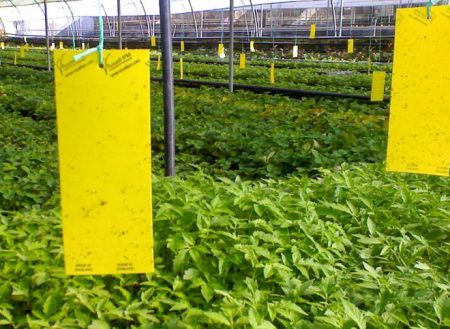
While updating the soil in the greenhouse, also let the new layer freeze well.
Many gardeners sprinkle snow in the greenhouse. This gives an excellent result. In addition to freezing the soil and destroying wintering larvae, snow during melting provides the beds with the necessary nutrients.
Be sure to carefully clean the remains of plants in the fall, wash the design of the greenhouse with disinfectants, cover the cracks.
If the site has already been infected, the soil should be watered with a solution of copper sulfate and bleach. Work with specialized proportions will help workers in specialized stores or experienced farmers. The composition of the solution and its strength depend on the composition of the soil. Sometimes it is enough to simply dig deep with the addition of a small amount of lime in the beds.
Chemical treatment
If to prevent the appearance of whiteflies did not work, you will have to carry out chemical treatment.You can, of course, try to deal with the pest and in safer ways, but today only chemical preparations give real results.
It is necessary to breed insecticides in accordance with the instructions on the packaging and be sure to observe safety precautions during work (use protective clothing, respirators and gloves).
Regardless of which drug was chosen for processing, it should be comprehensive. That is, simultaneously carry out watering, and spraying plants, and surface treatment of the greenhouse.
The following drugs are best suited in the fight against whitefly:
- Confidor. It is enough to carry out processing once a season. Recommended in spring 2 weeks before planting. But it can also be applied at any stage of the growing season;
- Fufanol or Mospilan. These solutions are also intended for single use;
- Verticillin or Pegasus. It can be used both for prevention, carrying out treatment in the early spring, and for treatment, in the middle of the growing season;
- Actellik. This is a universal remedy. It can be used to combat whitefly, regardless of its stage of development.
Biological method
The use of biological methods to control a butterfly pest is surprising for many of its unusualness. In a specialized store you need to purchase bottles or a disposable test tube (depending on the size of the greenhouse), which contains useful parasites - enkarsii.
Recall that a parasite is a creature that uses another living creature for its growth and development, and they do not always bring harm.
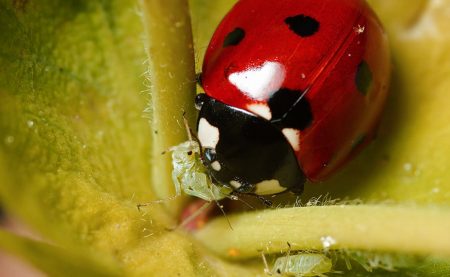
In the greenhouse, it will be necessary to open the container and evenly distribute its contents. In ten days, small insects will find whitefly larvae and lay each egg each (in rare cases, two). In a few days, the affected larvae will become mummies.
Ankarsia is bred in special laboratories to protect primarily greenhouse tomatoes and cucumbers from a pest butterfly.
Folk remedies
For small greenhouses and hotbeds, as well as for prevention, you can use alternative methods of protection against whiteflies. The butterfly does not like the smell of dill and ghoul, so these plants can be planted along the beds. You can also regularly spray the plantings and the greenhouse with infusions of garlic, tobacco or onion husks.
One of the radical methods is the ignition of smoke bombs. To do this, you need to install a metal stand in the greenhouse, place a checker on it, set fire to it and quickly exit, tightly closing all windows and doors. 3-5 days it is better not to go into the greenhouse, and after that it will be necessary to ventilate it well.
Glue traps work well. They must be placed around the perimeter of the greenhouse. They will attract the butterfly with their smell and color.
Use glue traps in blue and yellow. They more attract the attention of an insect, and therefore more effective.
Whitefly Prevention
It is necessary to carry out preventive work to protect landings regularly. First of all, this is a regular inspection of plants. Paying attention to every 5-7 bush, you can determine if there is a lesion or not. This should be done at least once a week, and when the windows and doors of the greenhouse will open often, every other day.
Butterfly larvae can fall on beds with infected seedlings or unprocessed tools and work clothes. To avoid this, it is advisable to treat young sprouts in a saturated pink solution of potassium permanganate before planting, and you can also water the wells with them. It is recommended that you use a separate tool for the greenhouse and regularly process it.
One way to prevent infection is to comply with planting standards. The denser the plants are located, the more favorable the environment for whiteflies will be created. Adequate ventilation is also of great importance. It is necessary that the air does not stagnate.
If mosquito nets are installed on the windows and doors of the greenhouse, the butterfly will not be able to fly inside.
Autumn cleaning of the greenhouse
After the end of the harvest season, thorough cleaning should be carried out in the greenhouse. If the structure is collapsible, it is enough to thoroughly wash it and treat it with disinfectants (you can use household chemicals, but only away from the beds). Dig the beds themselves and also treat them with a potassium permanganate solution or spill them with very hot water.
There are more works with capital buildings. It is necessary to wash the greenhouse not only inside, but also outside. Be sure to examine it for cracks and damage.
All plant residues should be removed from the beds, the topsoil should be removed by at least 7 cm, replaced with a new one and sanitized.
Sulfur checkers work well. With their help, it turns out to get rid of not only whiteflies and other insect pests, but also from fungi and infections. It is necessary to place the checker in the middle of the building on a metal base and set fire to it, quickly leaving the greenhouse. After two or three days it will be necessary to ventilate well.
If the structure is metal, it does not hurt to process it with rust-proofing agents, and it is better to whiten or wood the tree with varnish.
At the very end of the work, the soil cleared of plant debris should be shed with a solution of vitriol (250 g per bucket of water.)
Carrying out the autumn cleaning of the greenhouse, take care not only of disinfection, but also of the safety of the structure. It will not hurt to strengthen it with props in order to withstand a thick layer of snow, as well as take care of the absence of cracks and the tight closing of doors and windows.
Whitefly invasions should not be feared. You just need to carry out preventive work in time and study the recommendations of professionals in case the defeat does occur.




 Low-growing tomatoes, without pinching: 5 of the most delicious varieties
Low-growing tomatoes, without pinching: 5 of the most delicious varieties Why tomato seedlings grow poorly
Why tomato seedlings grow poorly We grow a tomato in a shell
We grow a tomato in a shell Growing tomatoes without watering according to the method of Kazarin
Growing tomatoes without watering according to the method of Kazarin